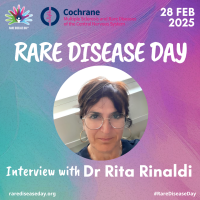
Approximately 300 million people worldwide are living with a rare disease. With over 6,000 identified rare diseases, and 72% of them being genetic in nature, the need for awareness, research, and effective treatments is more critical than ever. Cochrane MS and Rare Diseases of the CNS is committed to supporting and participating to research initiatives that enhance the understanding and management of these conditions, most of which impact the central nervous system.
One such initiative is the Project COLT-MNGIE, which is promoted by Mitocon - the Italian advocacy group for patients with mitochondrial diseases.
This project aims to develop a Core Outcome Set (COS) for Mitochondrial Neurogastrointestinal Encephalomyopathy (MNGIE), providing a consistent framework for evaluating the efficacy and safety of liver transplantation and other promising enzyme-replacement treatments.
MNGIE is a rare autosomal recessive disorder caused by mutations in the TYMP gene, which leads to a deficiency of thymidine phosphorylase (TP). This deficiency results in the accumulation of thymidine and deoxyuridine, which disrupts the maintenance and integrity of mitochondrial DNA. The prevalence of MNGIE is unknown, and fewer than 200 cases have been reported in the medical literature since 2011.
Clinically, the disease is characterized by severe and progressive gastrointestinal and neurological manifestations. Patients often experience severe gastrointestinal dysmotility, resulting in symptoms such as nausea, vomiting, diarrhoea, abdominal pain, malnutrition and weight loss/cachessia. Neurological involvement is characterized by ophthalmoparesis, hearing loss and polyneuropathy. The onset typically occurs in the second decade of life and the life expectancy for affected individuals is around 37 years. Signs and symptoms of MNGIE are heterogeneous and confirmatory diagnostic tests are not routinely performed by most laboratories, accounting for common misdiagnosis.
In occasion of Rare Diseases Day 2025, we had to pleasure to speak with Dr Rita Rinaldi, neurologist at the IRCCS Institute of Neurological Sciences of Bologna, in the department located at the S. Orsola-Malpighi Hospital, a vital contributor to the COLT-MNGIE project. Dr Rinaldi brings a wealth of knowledge and experience, particularly in the diagnosis and treatment of patients affected by rare neurological diseases, including MNGIE.
Source:
- Hirano M, Carelli V, De Giorgio R, Pironi L, Accarino A, Cenacchi G, D'Alessandro R, Filosto M, Martí R, Nonino F, Pinna AD, Baldin E, Bax BE, Bolletta A, Bolletta R, Boschetti E, Cescon M, D'Angelo R, Dotti MT, Giordano C, Gramegna LL, Levene M, Lodi R, Mandel H, Morelli MC, Musumeci O, Pugliese A, Scarpelli M, Siniscalchi A, Spinazzola A, Tal G, Torres-Torronteras J, Vignatelli L, Zaidman I, Zoller H, Rinaldi R, Zeviani M. Mitochondrial neurogastrointestinal encephalomyopathy (MNGIE): Position paper on diagnosis, prognosis, and treatment by the MNGIE International Network. J Inherit Metab Dis. 2021 Mar;44(2):376-387. doi: 10.1002/jimd.12300. Epub 2020 Sep 8. PMID: 32898308; PMCID: PMC8399867.
- NORD (National Organization for Rare Diseases) – MNGIE
- What are the current challenges in diagnosing MNGIE?
The diagnostic difficulties lie in the extreme rarity of the disease and in the insidious onset with non-specific symptoms. These aspects explain the high rate of misdiagnosis and of delayed diagnosis. Obviously, late diagnosis, when the patient is in poor clinical conditions, reduces the therapeutic options currently available.
- Could you tell us more on the treatment options currently available for MNGIE patients?
Keeping in consideration that no therapy has definitely been proven to be effective in MNGIE, the goal of treatment is lowering plasmatic dThd/dUrd levels by permanently replacing the thymidine phosphorylase (TP) enzyme, which in people with MNGIE is markedly reduced or even absent. Currently available therapeutic options include Haematopoietic Stem Cell Transplantation (HSCT) ant Liver Transplantation (LT). Both treatments are effective in slowing the course of the disease but pose serious risks with a transplant-related mortality of about 30%, particularly in people with advanced MNGIE. Gene therapy, currently under investigation as a permanent enzyme replacement treatment, is expected to be as effective as HSCT and LT, possibly with a better safety profile.
- What is the primary goal of the Project COLT-MNGIE?
The main aim of the COLT-MNGIE project is to develop a set of health outcomes (Core Outcome Set, or COS), relevant for clinicians and for people with MNGIE, that should be adopted as a minimum in clinical practice and in research to assess the severity of the condition and the efficacy and safety of treatments. The set is being developed through a formal consensus process engaging researchers, clinicians and people with MNGIE. Given the extreme rarity of the disease, I believe it is crucial that health professionals dealing with MNGIE share common evaluation criteria and definitions, allowing them to speak the same language, in particular when it comes to assessing and reporting the effectiveness and safety of the interventions adopted. From this perspective, the development of a COS can represent a tool that on the one hand facilitates consistency in evaluation and on the other makes the outcomes of patients undergoing the same treatment comparable, allowing data pooling among different case series. For such ultra-rare diseases this aspect helps clinicians and patients in the challenging shared decision-making process.
- How do you believe the Project COLT-MNGIE will improve the quality of life for patients affected by MNGIE and their families?
The COLT-MNGIE project will allow sharing a common approach to evaluate benefits and risks of a therapy in a very rare disease, also taking into account the patients' perspective. A focus group engaging people with MNGIE and their carers was conducted with the support of Mitocon ODV, the Italian non-profit organization advocacing for people with mitochondrial diseases and promoter of this initiative. This way, we identified which dimensions of one’s life are mostly influenced by the disease and how much each one of them impacts daily activities. The output of the focus group informed the content of a survey that was disseminated worldwide to collect from people with MNGIE and their carers their perspective about the most valuable objectives that future treatments should have. At the same time, a formal consensus process is ongoing among health professionals in order to develop a minimum set of health outcomes (clinical as well as instrumental) to be adopted in clinical practice to assess people with MNGIE. The COS developed in such way, including the patients’ perspective, will help both doctors and people with MNGIE in the process of evaluating the effectiveness and safety of currently available (as well as upcoming) treatments and therefore in therapeutic shared decision-making.

| Rita Rinaldi is a neurologist at the IRCCS Institute of Neurological Sciences of Bologna, within the department based at S. Orsola-Malpighi Hospital. Throughout her career, she has specialized in neuroepidemiology, clinical neurology, neuromuscular diseases, mitochondrial encephalomyopathies, and severe gastrointestinal motility disorders. |
